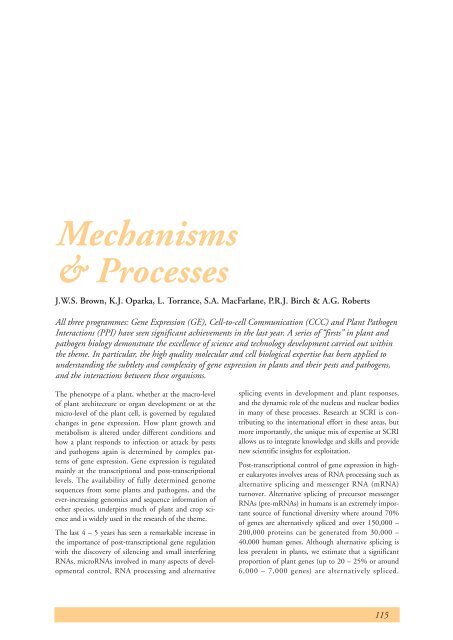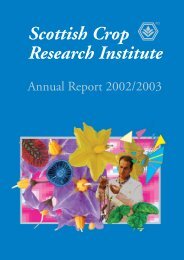SCRI Annual Report 2003/2004 - Scottish Crop Research Institute
SCRI Annual Report 2003/2004 - Scottish Crop Research Institute
SCRI Annual Report 2003/2004 - Scottish Crop Research Institute
Create successful ePaper yourself
Turn your PDF publications into a flip-book with our unique Google optimized e-Paper software.
Mechanisms<br />
& Processes<br />
J.W.S. Brown, K.J. Oparka, L. Torrance, S.A. MacFarlane, P.R.J. Birch & A.G. Roberts<br />
All three programmes: Gene Expression (GE), Cell-to-cell Communication (CCC) and Plant Pathogen<br />
Interactions (PPI) have seen significant achievements in the last year. A series of “firsts” in plant and<br />
pathogen biology demonstrate the excellence of science and technology development carried out within<br />
the theme. In particular, the high quality molecular and cell biological expertise has been applied to<br />
understanding the subtlety and complexity of gene expression in plants and their pests and pathogens,<br />
and the interactions between these organisms.<br />
The phenotype of a plant, whether at the macro-level<br />
of plant architecture or organ development or at the<br />
micro-level of the plant cell, is governed by regulated<br />
changes in gene expression. How plant growth and<br />
metabolism is altered under different conditions and<br />
how a plant responds to infection or attack by pests<br />
and pathogens again is determined by complex patterns<br />
of gene expression. Gene expression is regulated<br />
mainly at the transcriptional and post-transcriptional<br />
levels. The availability of fully determined genome<br />
sequences from some plants and pathogens, and the<br />
ever-increasing genomics and sequence information of<br />
other species, underpins much of plant and crop science<br />
and is widely used in the research of the theme.<br />
The last 4 – 5 years has seen a remarkable increase in<br />
the importance of post-transcriptional gene regulation<br />
with the discovery of silencing and small interfering<br />
RNAs, microRNAs involved in many aspects of developmental<br />
control, RNA processing and alternative<br />
splicing events in development and plant responses,<br />
and the dynamic role of the nucleus and nuclear bodies<br />
in many of these processes. <strong>Research</strong> at <strong>SCRI</strong> is contributing<br />
to the international effort in these areas, but<br />
more importantly, the unique mix of expertise at <strong>SCRI</strong><br />
allows us to integrate knowledge and skills and provide<br />
new scientific insights for exploitation.<br />
Post-transcriptional control of gene expression in higher<br />
eukaryotes involves areas of RNA processing such as<br />
alternative splicing and messenger RNA (mRNA)<br />
turnover. Alternative splicing of precursor messenger<br />
RNAs (pre-mRNAs) in humans is an extremely important<br />
source of functional diversity where around 70%<br />
of genes are alternatively spliced and over 150,000 –<br />
200,000 proteins can be generated from 30,000 –<br />
40,000 human genes. Although alternative splicing is<br />
less prevalent in plants, we estimate that a significant<br />
proportion of plant genes (up to 20 – 25% or around<br />
6,000 – 7,000 genes) are alternatively spliced.<br />
115
















